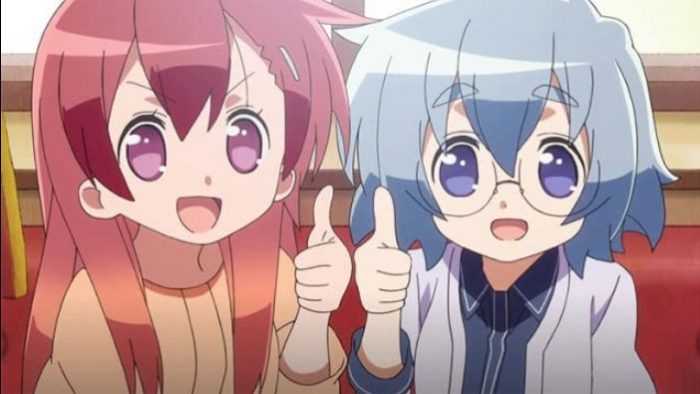Maesetsu! and Understanding Manzai Comedy


As this season’s Maesetsu! has already shown, Japanese comedy can be quite different from that of other cultures, even beyond the language barrier. The distinctive type of comedic duo act known as manzai is no exception. While we can’t promise to make you able to enjoy it like a Japanese person, understanding the background and context of manzai might help you better appreciate it, and perhaps Maesetsu! as well! Join us today as we shine a spotlight on manzai, its history, and unique points.
Origins
You may be surprised to learn that manzai is actually quite an old tradition tracing its roots over a thousand years ago all the way back to Japan’s Heian period where two entertainers would play messengers of the gods and perform acts where they celebrated while comedically arguing about said messages as part of New Year festivals. While these traditions set up the general format, mainly the duo, manzai in the modern sense really began in the late 1920s and 1930s and benefitted highly from new technology like the film and radio and Japan’s westernization in spreading its popularity. Modern manzai is widely considered to have started in Osaka by comedic pioneers Yokoyama Entatsu and Hanabishi Achako, known simply as Entatsu and Achako. This duo popularized the shabekuri or "non-stop chatting” manzai that is still the basis of most manzai today. This style is somewhat reminiscent of vaudeville acts like Abbott and Costello or Laurel and Hardy and focuses on near-constant pitter-patter chatting with some slapstick elements. Entatsu and Achako are also notable for wearing Western clothes in their performances giving manzai a more modern feeling than other forms of comedy like rakugo which still uses traditional Japanese clothes. Interestingly, even today Osaka and Kansai-dialect are still very prominent in manzai and a lot of Japanese comedy in general.
Boke & Tsukkomi
The core of manzai can be explained in the roles of the two characters called boke and tsukkomi. These are analogous to the concepts of "funny man" and "straight man" in Western comedy. Boke comes from the word bokeru which means to become befuddled, senile, or otherwise stupid while tsukkomi comes from tsukkomu which means something like butting in, questioning, or quipping. Thus manzai usually takes the form of a fast-paced dialogue skit with the boke misunderstanding something while the tsukkomi butts in to berate them or otherwise react to their silliness, often only being slightly more intelligent themselves. These duos are known as kombi in Japan. It’s worth mentioning that while boke and tsukkomi originated in manzai, the terms and relationship concept are widespread throughout Japanese comedy and other media like anime where it can been seen in many of Konata and Kagami’s interactions in Lucky☆Star, Nichijou’s Hakase and Nano, etc.
Modern Manzai and Maesetsu!
In contemporary Japan, manzai is still quite relevant and popular and many television and film celebrities started off in manzai kombi like Hamada Masatoshi (tsukkomi, also the Japanese voice of Shrek if that gives you an idea of his stage personality) and Matsumoto Hitoshi (boke) of the famous group Downtown and superstar Kitano “Beat” Takeshi (boke) of Two Beat, who is also an acclaimed actor and director. The most important event for manzai is probably the annual M-1 Grand Prix competition but it is also a fixture of variety programs on Japanese TV and radio. While it is still a male-dominated field, in the last ten years or so, more female manzai acts have become popular like Othello, Harisenbon, and Oasis which segues nicely into Maesetsu! As evidenced by his earlier series Lucky☆Star, Maesetsu! creator Yoshimizu Kagami is clearly such a big manzai fan that his next major work is all about it and specifically focuses on female performers that are currently becoming popular, albeit his are a lot more moe-focused. Maesetsu! has all of the manzai hallmarks with distinctive kombi names like R凸 (RDeco), clear boke-tsukkomi roles, and even references to the M-1 Grand Prix. It’s also interesting that the main cast’s older mentor group of sorts, Freak, is mixed-gender which is uncommon but certainly not unheard of.
Final Thoughts
Altogether, comedy can be something easy to get lost in translation and manzai is certainly prone to that, particularly with its reliance on Japanese cultural references, often breakneck speed, and use of puns that only really work in Japanese. That being said, it's an artform that can still be appreciated with the proper mindset and anime like Maesetsu! might help bring this style of comedy to a wider audience thanks to the popularity of anime and the power of cute girls. In any case, we hope you enjoyed this foray into manzai! Please let us know what you think of Japanese comedy and Maesetsu! in the comments section below and be sure to stick around Honey’s Anime for more coverage of Japanese pop culture! Until next time, see ya~!
[recommendedPost post_id='306870' url='' title='' img='' class='' widget_title=''] [recommendedPost post_id='291516' url='' title='' img='' class='' widget_title='']

No comments